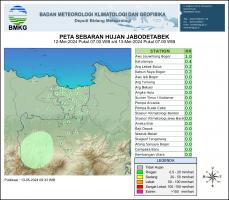| Current Cyclone | Cyclone Outlook | After Events Report | Historical Cyclone | Annual Reports | Cyclone Names | Learn About TC |
What Is Cyclone
Tropical cyclone is strong storm. Average radius of tropical cyclone reaches 150 to 200 km. Cyclone forming over wide ocean generally with warm surface temperature, more than 26.5° C. Strong wind near the centre reach 63 km/hour or more.

Gambar: Perbandingan ukuran Typhoon Tip (1979) dengan Siklon Tropis Tracy (1977). The average radius is extent to 150 to 200 km. Tropical cyclone form on warm wide ocean, more than 26.5° C. Strong rotated wind near the centre reaches more than 63 km/hour.
Technically, tropical cyclone is a synoptic non-frontal low pressure system developing over warm tropical ocean with convective cloud band and maximum wind at least 34 knot at extending more than half way around the centre, and persist for at least six hours.
Sometime an eye, an area of light wind and clear sky is developed in the centre of the cyclone. Diameter of the eye varied from 10 to 100 km. The eye is surrounded by eye wall, a ring of cloud of about 16 km high where the most destructive wind and heaviest rain occur.
Averaged cyclone life time is about 3 to 18 days. Since energy for the cyclone is gained from warm ocean, it will be weakened or decay when it moves over cold water or land.
Cyclone is known with several term, namely "tropical storm" or "typhoon" if developing over West Pacific, "cyclone" if developing over India or Australia, and "hurricane" if developing over Atlantic.
Maximum Wind Speed
Maximum wind speed is defined as the strongest 10 minutes averaged surface wind occurring within the cyclone circulation. This strongest wind usually occurs within ring area near the centre, or, in the existence of an eye, within the eye wall.
Tropical Cyclone Size
Tropical cyclone size describe radius of area experiencing at least 34 knot wind. The size is varied from 50 km (Cyclone Tracy, 1977) to 1100 km (Cyclone Tip, 1979).
Tropical Cyclone Basin
Cyclone basin covered Western Atlantic, Eastern Pasific, Northern West Pasific, Indian Ocean, Australia and Southern Pasific. About 2/3 cyclone occur in Northern Hemisphere. About 65% occur between 10° to 20° from the equator, and only 13% cyclone occurs in more than 20o latitude. In low latitude (0° - 10° ) cyclone does rarely occur. Table: Basin Nomenclature and Areal Extent
| No | Basin Name | Areal Extent |
|---|---|---|
| 1 | North Atlantic | North Atlantic Ocean, Caribbean Sea and Gulf of Mexico |
| 2 | Eastern North Pacific | North America to 180° E |
| 3 | Western North Pacific | West of 180° E, including South China Sea |
| 4 | North Indian | Bay of Bengal and Arabian Sea |
| 5 | Southwest Indian | South Indian Ocean west of 100° E |
| 6 | Southeast Indian Ocean / Australia | Shouthern Hemisphere 100 - 142° E |
| 7 | Southwest Pasific / Australia | Southern Hemisphere east of 142° E |










